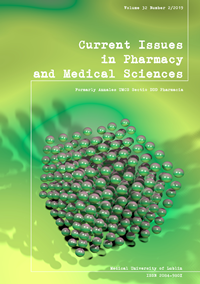Structural changes in liver under conditions of experimental hemorrhagic stroke
DOI:
https://doi.org/10.2478/cipms-2019-0013Keywords:
liver, stroke, capillary sinusoids, hepatocytes injuryAbstract
The article describes the results of histological and morphometric studies of liver in Balb/c mice with hemorrhagic stroke. The hemorrhagic stroke was modeled in the animals by administering autoblood in volume of 0.1 ml in the right hemisphere, and within 5, 10 and 30 days an analysis of structural changes in the liver was performed. Progressive changes were established in terms of 5-10 days of the experiment. This consisted of changes in the sinusoidal capillaries and notable changes in the central veins of the liver lobuli. Herein, acute dilatation and erythrocytal stasis were most pronounced around the lumen of the central veins, while hepatocytes with signs of necrosis (severe cytoplasmic swelling, vacuolar dystrophic changes) were detected in the sinusoid capillaries. The results of the morphometry indicated an increase in the area of the nucleus and the cells caused by intracellular swelling, domination of euchromatin and decrease of total density of chromatin in nuclei. Partial regression of the diameter of sinusoidal capillaries and the area of hepatocytes were detected on the 30thday of the experiment. The changes in the sinusoidal capillaries of the liver lobules are assessed as secondary to stroke, as well as to changes in organ microcirculation, and are associated with dystrophic changes in the hepatocytes.
References
1. Zhang X, Qi X, Yoshida EM, Méndez-Sánchez N, Hou F, Deng H, Wang X, et al. Ischemic stroke in liver cirrhosis: epidemiology, risk factors, and in-hospital outcomes. Eur J Gastroenterol Hepatol. 2018; 30(2):233-40.
2. Yang CY, Lin MT. Oxidative stress in rats with heatstroke-induced cerebral ischemia. Stroke. 2002;33(3):790-4.
3. Gong W-H, Zheng W-X, Wang J, Chen S-H, Pang B, Hu X-M, Cao X-L. Coexistence of hyperlipidemia and acute cerebral ischemia/reperfusion induces severe liver damage in a rat model. World Journal of Gastroenterology. WJG. 2012;18(35):4934-43.
4. Muscari A, Collini A, Fabbri E, Giovagnoli M, Napoli C, Rossi V, et al. Changes of liver enzymes and bilirubin during ischemic stroke: mechanisms and possible significance. BMC Neurology. 2014;14:122.
5. Savosko SI, Chaikovsky JuB, Pogorela NKh, Makarenko AN. Features of histostructural changes in rat cerebral cortex in hemorrhagic stroke modeling. International Journal of Physiology and Pathophysiology. 2013;4(2):113-21.
6. Gumenyuk AV, Motorna NV, Rybalko SL, Savosko SI, Sokurenko LM, Chaikovsky YuB. Mutual influence of herpes virus infection activation and cerebral circulation impairment on the state of brain cells. Biopolym Cell. 2016;32(2):126-30.
7. Parikh NS, Merkler AE, Schneider Y, Navi BB, Mamel H. Dischange disposition after stroke in patients with liver disease. Stroke. 2017;48(2):476-8
8. Meythaler JM, Hazlewood J, DeVivo JM, Rosner М. Elevated liver enzymes after nontraumatic intracranial hemorrhages. Arch Phys Med Rehabil. 1998;79:766-71.
9. Abdeldyem SM, Goda T, Khodeir SA, Abou Saif S, Abd-Elsalam S. Nonalcoholic fatty liver disease in patients with acute ischemic stroke is associated with more severe stroke and worse outcome. J Clin Lipidol. 2017;11(4):915-9.
10. Tziomalos K, Giampatzis V, Bouziana SD, Spanou M, Papadopoulou M, Pavlidis A, et al. Association between nonalcoholic fatty liver disease and acute ischemic stroke severity and outcome. World Journal of Hepatology. 2013;5(11):621-6.
11. Cuadrado-Godia E, Jiménez-Conde J, Ois A, Rodríguez-Campello A, García-Ramallo E, Roquer J. Sex differences in the prognostic value of the lipid profile after the first ischemic stroke. J Neurol. 2009;256(6):989-95.
12. Tziomalos K, Giampatzis V, Bouziana SD, Spanou M, Kostaki S, Papadopoulou M, et al. Prognostic significance of major lipids in patients with acute ischemic stroke. Metab Brain Dis. 2017; 32(2):395-400.
13. Pineda S, Bang OY, Saver JL, Starkman S, Yun SW, Liebeskind DS, et al. Association of serum bilirubin with ischemic stroke outcomes. J Stroke Cerebrovasc Dis. 2008;17:147-52.
14. Sevastos N, Savvas SP, Rafailidis PI, Manesis EK. Cholestasis in acute stroke: an investigation on its prevalence and etiology. Scand J Gastroenterol. 2005;40:862-6.
15. Sanfilippo F, Veenith T, Santonocito C, Vrettou CS, Matta BF. Liver function test abnormalities after traumatic brain injury: is hepato-biliary ultrasound a sensitive diagnostic tool? British Journal of Anaesthesia. 2014;112(2):298-303.
16. Zhu R, Guo W, Fang H, Cao S, Yan B, Chen S, et al. Kupffer cell depletion by gadolinium chloride aggravates liver injury after brain death in rats. Molecular medicine reports. 2018;17:6357-62.
17. Wang YY, Lin SY, Chuang YH, Sheu W HH, Tung KC, Chen CJ. Activation of hepatic inflammatory pathways by catecholamines is associated with hepatic insulin resistance in male ischemic stroke rats. Endocrinology. 2014;155(4):1235-46.
18. Motorna N, Rybalko S, Kvitnitskaya-Ryzhova T, Starosyla D, Strokina I, Kaminsky R, et al. Ultrastructural changes in murine liver following HSV infection and stroke. Ultrastructural changes in murine liver following HSV infection and stroke. Curr Issues Pharm Med Sci. 2018;31(1):10-12.
19. Motorna NV, Rybalko SL, Sokurenko LM, Starosyla DB, Savosko SI, Chaikovsky YuB. Patterns of herpetic infection reactivation in the liver. Microbiology Journal. 2017;79(5):70-9.
20. Gumenyuk A, Motorna N, Rybalko S, Savosko S, Sokurenko L, Starosyla D, et al. Development of herpetic infection associated with stroke and its correction with acyclovir. Curr Issues Pharm Med Sci. 2017;30(1):20-3.
21. Motorna NV, Rybalko SL, Starosyla DB, Guzyk MM, Strokina IG, Kaminsky RF, et al. The study of leukocyte phagocytic activity in the presence of herpetic infection and stroke. Wiad Lek. 2018;71(1 pt 2):155-9.
Downloads
Published
Issue
Section
License
Copyright (c) 2019 Autors

This work is licensed under a Creative Commons Attribution-NonCommercial-NoDerivatives 3.0 Unported License.


